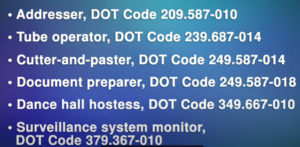Update on Obsolete Jobs
Post Author:
Kaylee Smith
Date Posted:
December 21, 2023
About:
Share This:
By now, most of us know the DOT was last updated in 1991 and even its author, the Department of Labor, has long abandoned its use. Since at least 2011, SSA has known that some of the jobs identified in the Dictionary of Occupational Titles (DOT) are obsolete. To date, SSA has refused to admit what everyone knows. It looks like SSA is starting to acknowledge the obsolescence of at least six jobs and NOSSCR will continue to push on this issue.
In 2011, a study commissioned by SSA concluded there were at least five jobs identified in the DOT that were obsolete. Trapani and Harkin, Occupational and Medical-Vocational Claims Review Study (2011). A dozen years later, SSA still has not formally conceded any of these jobs are obsolete.
Things may be changing. In March of this year, SSA came out with an updated version of the Vocational Expert Handbook (2023). SSA also released a video to go along with the updated Handbook. The video includes a short demo including cross-examination. The video specifically discusses six jobs:

Vocational Expert (VE) Handbook Update 2023 (video) (Vocational Expert (VE) Handbook Update 2023). Four of these jobs were identified as obsolete by Trapani and Harking. The six jobs are listed below with the DOT description for each job and, where available, with a recent judicial discussion of obsolescence.
Addresser, DOT Code 209.587-010Addresses by hand or typewriter, envelopes, cards, advertising literature, packages, and similar items for mailing.
- This Court, relying on many cases pertaining to this issue, found in Catherine G. v. Comm’r of Soc. Sec., No. 3:20-cv-05741-BAT, 2021 WL 1541178, at *3 (W.D. Wash. Apr. 20, 2021), that the addresser position does not exist in significant numbers. See Skinner v. Berryhill, No. CV 17-3795-PLA, 2018 WL 1631275, at *6 (C.D. Cal. Apr. 2, 2018) (“[I]t is not unreasonable to assume that the occupation of ‘addresser,’ which—as described by the DOT—provides for addressing envelopes by hand or by typewriter, is an occupation that has significantly dwindled in number since 1991 in light of technological advances. That being the case, a reasonable mind would not accept the VE’s testimony that there are over 3,000 such positions in the region of California alone, or even that there are over 10,000 in the national economy.”); Brandie K. A. v. Saul, No. EDCV 19-01017-RAO, 2020 WL 2572461, at *4 (C.D. Cal. May 21, 2020) (“In addition to the Skinner court, other district courts in the Ninth Circuit have found the ‘obsolete’ argument persuasive and found that the ALJ erred in relying on the VE’s job numbers for the addresser position.”) (collecting cases).
- Lucas P. v. Comm’r of Soc. Sec., No. 22-CV-0170-TLF, 2022 WL 5240889, at *3 (W.D. Wash. Oct. 6, 2022)
According to the DOT, an “addresser” is someone who “addresses by hand or typewriter, envelopes, cards, advertising literature, packages, and similar items for mailing. May sort mail.” “Addresser,” U.S. Department of Labor, Dictionary of Occupational Titles (4th ed.1991), www.oalj.dol. gov/public/dot/references/dot02a.htm. It’s hard to believe that, as the vocational expert testified in this case, there are 200,000 people in the United States for whom this is a full-time job. And does anyone use a typewriter any more? Most addressing nowadays is either personal, as when one is sending a Christmas or get-well card, or automated, as in the case of business mailings, including mass mailings of advertisements or magazines. There is no indication that Alaura is capable of performing jobs typically found in automated mailing, such as barcoding, pre-sorting, list management, variable data laser printing, folding, inserting, tabbing, warehousing, and shipping. See Automated Mailing Systems, Inc., www.automailsys.com/.
Alaura v. Colvin, 797 F.3d 503, 508 (7th Cir. 2015)
Tube operator, DOT Code 239.687-014
- Receives and routes messages through pneumatic-tube system
Cutter-and-paster, press clippings, DOT Code 249.587-014
- Tears or cuts out marked articles or advertisements from newspapers and magazines, using knife or scissors. Records name of publication, page and location, date, and name of customer on label, and affixes label to clipping.
Document preparer, microfilming, DOT Code 249.587-018
- Prepares documents, such as brochures, pamphlets, and catalogs, for microfilming, using paper cutter, photocopying machine, rubber stamps, and other work devices.
- Plaintiff’s argument at step five, then, centers on whether the position of document preparer is obsolete. According to the Dictionary of Occupational Titles (“DICOT”), a worker in this position:
- Prepares documents, such as brochures, pamphlets, and catalogs, for microfilming, using paper cutter, photocopying machine, rubber stamps, and other work devices: Cuts documents into individual pages of standard microfilming size and format when allowed by margin space, using paper cutter or razor knife. Reproduces document pages as necessary to improve clarity or to reduce one or more pages into single page of standard microfilming size, using photocopying machine. Stamps standard symbols on pages or inserts instruction cards between pages of material to notify MICROFILM-CAMERA OPERATOR (business ser.) 976.682-022 of special handling, such as manual repositioning, during microfilming. Prepares cover sheet and document folder for material and index card for company files indicating information, such as firm name and address, product category, and index code, to identify material. Inserts material to be filmed in document folder and files folder for processing according to index code and filming priority schedule.
See Zacharopoulos v. Saul, No. 19-CV-5075, 2021 WL 235630, at *8 (E.D.N.Y. Jan. 25, 2021) (citing DICOT definition for document preparer.)
As the Zacharopoulos court summarized,
- That the technology underlying such a career is rapidly descending into obsolescence can be readily demonstrated: at this writing, a growing number of Americans are unacquainted with “microfilming,” “rubber stamps” and perhaps even “photocopying.” And while microfilm may still service some obscure, niche markets, in the digital economy, its trajectory resembles that of carbon paper and punch cards.
Id., 2021 WL 235630, at *8. With that in mind, an increasing number of courts have recognized the obsolete nature of the document preparer position and remanded for further administrative proceedings where there is no record evidence of other jobs existing in significant numbers that a plaintiff can perform. Id., 2021 WL 235630, at *8-9 (collecting cases); Kiiroja v, Comm’r of Soc. Sec., No. 20-CV-0078 (GRB), 2021 WL 934100, at *1-2 (E.D.N.Y. March 11, 2021) (remanding where only job identified by VE that plaintiff could actually perform was the obsolete document preparer position)4; see also Cunningham v. Astrue, 360 F. App’x 606, 615 (6th Cir. 2010) (“While the Social Security Commissioner does take administrative notice of [the DOT] when determining if jobs exist in the national economy, 20 C.F.R. § 404.1566(d)(1), common sense dictates that when such descriptions appear obsolete, a more recent source of information should be consulted. The two relevant descriptions here – document preparer and security camera monitor -strike us as potentially vulnerable for this reason. Without more, however, we cannot adequately review whether these job descriptions were up-to-date and, thus, whether the VE’s testimony was reliable.”); Wood v. Berryhill, No. 3:17-cv-5430 (RJB-BAT), 2017 WL 6419313, at *1 (W.D. Wash. Nov. 17, 2017) ((“[T]he positions of document preparer and nut sorter do not exist in significant numbers in the national economy.”); Czosnowski v. Comm’r, Soc. Sec., No. RDB-13-1467, 2014 WL 1660083, at *4 (D. Maryland, April 23, 2014) (holding that ALJ’s reliance on the VE testimony that document preparer position exists “in significant numbers in the national economy is not, on the current record consisting exclusively of the VE’s reliance on a twenty-year-old [DICOT], supported by substantial evidence.”).
Corey S. v. Comm’r of Soc. Sec., No. 5:20-CV-0678 (ML), 2021 WL 2935917 (N.D.N.Y. July 13, 2021)
Host/Hostess dance hall, DOT Code 349.667-010
- Participates, as social partner, in dancing, dining, drinking, conversation with patrons to increase business of public dancehall.
Surveillance-system monitor, DOT Code 379.367-010
- Monitors premises of public transportation terminals to detect crimes or disturbances, using closed circuit television monitors, and notifies authorities by telephone of need for corrective action.
The video specifically recommends VEs be prepared to explain whether these jobs are still performed in the same way as described in the DOT and, if not, the differences and the number of jobs currently. SSA and the video continue to ignore reality. For example, there are no addresser jobs anymore as described in the DOT because no one addresses envelopes by hand or by typewriter as a full-time job. For example, the addresser job, as currently performed, uses a computer and is generally semi-skilled. SSA pretends the job is still unskilled.
More recently, in September, OHO’s Office of Continuing Education Programs (OCEP) conducted a training. We believe that OHO suggested ALJs should not cite or rely on these jobs. If a VE testifies that such a job is available, again the ALJ should inquire as to whether these jobs are still performed in the same way as described in the DOT and, if not, the differences and the number of jobs currently. (NOSSCR has requested a copy of the training recording and written materials).
Hopefully, things are changing. We are starting to see Appeals Council remands of ALJ decisions citing these jobs. And NOSSCR continues to advocate for honest, accurate, and reliable vocational determinations. Expect more information on this issue in the next Forum.
Supported By
Insurance Branch
NOSSCR is pleased to announce its year-long partnership with Insurance Branch.



